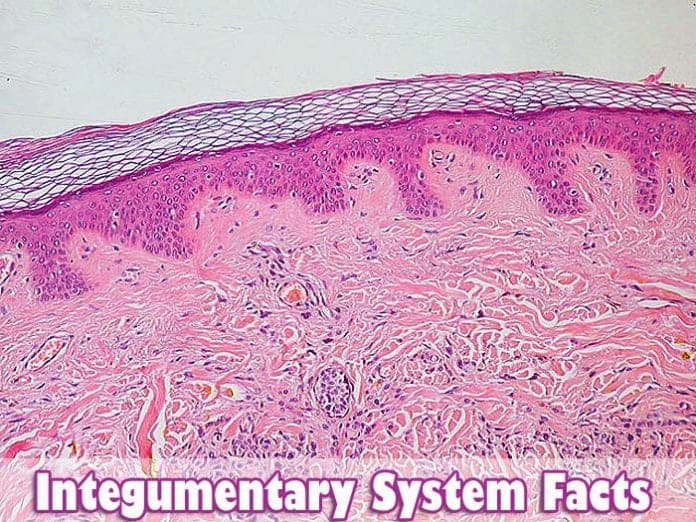
Integumentary System Facts: The skin is the human body’s first line of defense against microorganisms, parasites and the environment in general.
It protects the deeper layers of the skin and the internal system of the human body, apart from providing a large surface area for regulating body temperature through loss or retention of water.
Also known as the integumentary system, the skin, and its appendages are responsible for a plethora of different functions. It primarily consists of the skin, nails, hair, and glands.
Table of Contents
- The skin is primarily made up of two layers – The epidermis and the dermis.
- The skin is considered the largest organ of the body.
- Thick and thin skin differs in composition throughout the body.
- Vitamin D synthesis is initiated in the skin.
- The skin is rich in receptors that allow us to experience sensations.
- The skin contains different kinds of receptors for different kinds of responses.
- One of the essential functions of the skin is thermoregulation.
- The amount of sweat a human body produces ranges from 500ml to 1.5L depending on the external environment.
- Hair is an external appendage of the integumentary system whose characteristics are defined by heredity.
- Nails are keratinous external appendages of the integumentary system.
- separate branch of medicine is dedicated to the study of the integumentary system – Dermatology.
- There are five different kinds of cells in the epidermis of the skin.
- Blood vessels are known as the arterioles aid in thermoregulation.
- The epidermis is made up of five distinct layers.
- Dermatophogoides , also known as dust mites, are organisms that feed on skin cells.
- The dermis is made up of two distinct zones.
- The hypodermis is the layer that is found between the epidermis and the dermis.
- The most important substance that gives our skin color is melanin.
- Deficiency of oxygen in the skin leads to the bluish appearance of the skin known as cyanosis.
- The UV r adiation can damage the skin.
- A s single strand of hair is made up of many different parts.
- Each strand of hair goes through a cycle of hair growth with three developmental stages.
- Skin cancer is caused by damaging effects of UV radiation from the sun.
- Sun-screen contains a unique sun protection factor that can protect skin from harmful UV radiations.
- There are two kinds of sweat glands in the integumentary system.
Top Integumentary System Facts
Below let’s explore the top 25 interesting facts about the integumentary system.
The skin is primarily made up of two layers – The epidermis and the dermis.
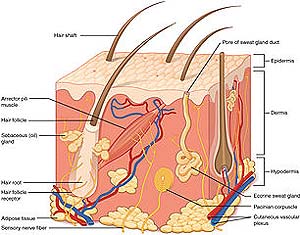
- The epidermis is the outer layer of the skin that consists of stratified squamous epithelial cells.
- A deeper layer, called the dermis, lies under the epidermis and consists of connective tissue.
- A third layer called the hypodermis lies underneath the dermis.
![]()
The skin is considered the largest organ of the body.
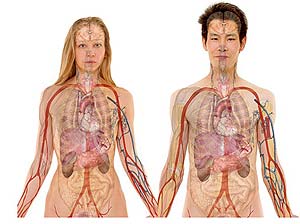
- The skin is also the heaviest organ of the body, covering a total area ranging from 1. 5 to 2 square meters.
- It makes up 15% of the total body weight of a human being.
- In terms of thickness, the skin in some places is 1 to 2 mm thick, whereas, in others, it can range from 0. 5mm to 6mm, depending on the location.
- The thickness of the skin is measured based on the thickness of the outer layer, i.e., the epidermis.
![]()
Thick and thin skin differs in composition throughout the body.

- Thick skin is found on the palms of the hands and the foot soles. This arrangement is due to a thick layer of dead skin found in these regions, called the stratum corneum.
- This part of the skin is rich in sweat glands but lacks the presence of oil glands (or sebaceous glands) and hair follicles.
- Thin skin is found in regions like the eyelids and the rest of the body. It is rich in sebaceous glands and hair follicles but lacks sweat glands.
![]()
Vitamin D synthesis is initiated in the skin.

- The skin, on exposure to sunlight, produces vitamin D for the human body.
- The liver and the kidneys then carry on the process.
- A lack of Vitamin D is associated with reduced exposure to sunlight, commonly found in colder countries.
![]()
The skin is rich in receptors that allow us to experience sensations.

- The skin, containing hair and hair follicles, is involved in the sensory pathway that allows humans to experience the sensation of touch and temperature.
- Any changes in the surrounding environment are sensed by the hair follicles, which transmit the signal to the neurons in the underlying skin.
- These neurons transmit this information via the central nervous system to the brain that then facilitates an appropriate reaction.
![]()
The skin contains different kinds of receptors for different kinds of responses.

- The Meissner corpuscle, also called the tactile corpuscle, is responsible for a response towards the stimulus of light touch.
- The Pacinian corpuscle or the lamellated corpuscle is responsible for a response towards vibration.
- Merkel cells also respond to touch that carries stimulus to the motor neurons present in the underlying layers of the skin.
![]()
One of the essential functions of the skin is thermoregulation.
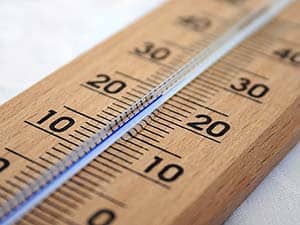
- Changes in temperature in the environment are sensed by the sensors present in the skin.
- With the aid of the sympathetic nervous system, the integumentary system regulates body temperature in response to the changes in the surrounding environment.
- The main accessories in thermoregulation are the sweat glands, which control the amount of water loss or retention through the skin’s surface depending on the environmental temperature. This is how the body is maintained at a stable temperature of 37 Degrees Celcius under normal conditions.
![]()
The amount of sweat a human body produces ranges from 500ml to 1.5L depending on the external environment.

- In the resting state, the human body produces around 500ml of sweat daily. It is known as insensible perspiration.
- Under higher temperatures or high levels of activity, the sweat glands stimulated by the sympathetic nervous system produce an increased amount of sweat that can range from 0.7L to 1.5L per hour.
- The body temperature is brought back to normal due to the evaporation of sweat from the skin’s surface.
![]()
Hair is an external appendage of the integumentary system whose characteristics are defined by heredity.
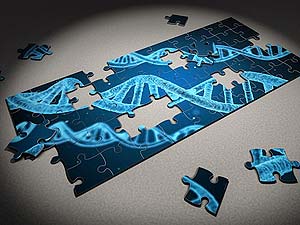
- Hair grows in different patterns on the body for different people, except for the lips, palms, and feet.
- The length, color, texture, type, and volume of hair are decided by genetic material and is passed on via heredity from generation to generation.
- Hair color is determined by a pigment known as melanin. The amount of melanin varies – the higher the melanin, the darker the hair.
- Our hair grows approximately 1 cm every month, and about 100 single hairs are shed daily.
![]()
Nails are keratinous external appendages of the integumentary system.

- The nails grow on the hands and the feet, under a white shaped region called the lunula.
- The protein keratin makes up the nail and the cuticle which covers the nail root.
- The nails on the hands grow at approximately 0.5 mm per week, whereas those on the toes grow much slower.
![]()
separate branch of medicine is dedicated to the study of the integumentary system – Dermatology.
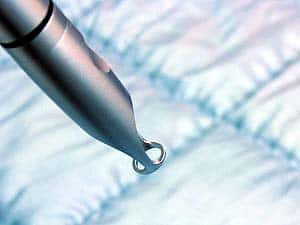
- Dermatology is a branch of medical science that involves studying the integumentary system, particularly the hair and the skin.
- Observing the skin and external appendages can point to underlying disorders or diseases.
- Exposure to radiation, UV rays, and harmful chemicals can damage the skin and hair.
![]()
There are five different kinds of cells in the epidermis of the skin.
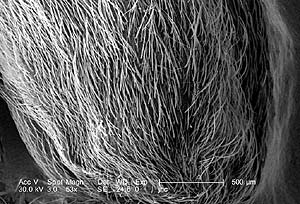
- Stem cells – are undifferentiated precursor cells that proliferate on receiving a stimulus and differentiate into cells of the skin called keratinocytes, found in the deeper layers of the epidermis.
- Keratinocytes – are the cells that make up the majority of the epidermal layer and synthesize keratin.
- Melanocytes are found in a layer known as the stratum basale and synthesize melanin.
- Tactile cells are found in the basal layer and are the receptors for touch, whereas dendritic cells are the immune cells that protect the layers of the skin from pathogens.
![]()
Blood vessels are known as the arterioles aid in thermoregulation.
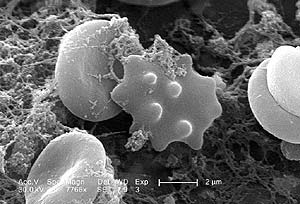
- Tiny vessels known as the arterioles present in the dermal layers of the skin dilate when temperatures are high. This allows heat to dissipate into the surrounding environment.
- The reddish skin color that appears when exercising is due to the dilation of the arterioles.
- In conditions of lower temperature, the arterioles constrict, thereby conserving heat in the body and preventing body temperature from dropping.
![]()
The epidermis is made up of five distinct layers.
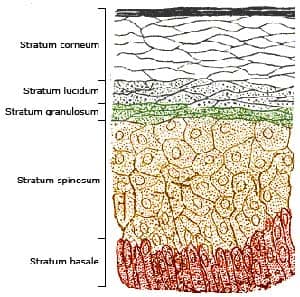
- The first layer known as the stratum basale consists mainly of cuboidal stem cells and keratinocytes that lie on the basement membrane.
- Next, the stratum spinosum consists of scattered keratinocytes. This is a relatively thicker layer and contains few dendritic cells.
- The stratum granulosum consists of flat keratinocytes. The stratum lucidim is a layer found only in a thick skin that lies above the stratum granulosum.
- The outermost layer is the stratum corneum, which is made up of dead keratinized cells that form the surface of the skin.
![]()
Dermatophogoides , also known as dust mites, are organisms that feed on skin cells.
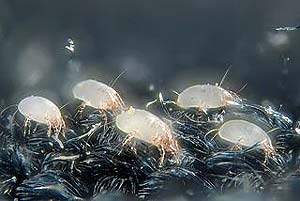
- The dust mite is a common household pest that feeds on dust particles that settle on surfaces, including the skin.
- They feed on keratin and thrive on mattresses, pillows, and any surfaces with scattered keratin.
- Some people develop an allergy to these dust mites.
![]()
The dermis is made up of two distinct zones.
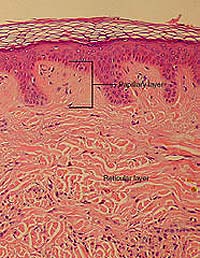
- Situated below the epidermis is a layer rich in connective tissue known as the dermis. It primarily comprises collagen, reticular fibers, fibroblasts, and elastic fibers.
- The Papillary layer is a thin dermis layer consisting of areolar tissue rich in small blood vessels and immune cells.
- The reticular layer is a thicker and more profound layer of the dermis that contains collagen, connective tissue, and adipocytes.
![]()
The hypodermis is the layer that is found between the epidermis and the dermis.
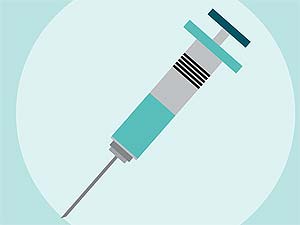
- Also known as the subcutaneous layer, the hypodermis is found as an indistinct boundary between the epidermis and the dermis.
- It is composed of areolar tissue and adipocytes.
- It is richly supplied with blood vessels, and subcutaneous injections are administered in this layer.
![]()
The most important substance that gives our skin color is melanin.

- Melanin is produced by melanocytes found in the skin. There are two kinds of melanin pigment – eumelanin, which is brownish-black in color and pheomelanin, which is rich in sulfur and is reddish-yellow.
- In individuals with darker skin, more melanin is produced, is found in tight clusters together, and is degraded very slowly.
- In individuals with lighter skin, melanin is found clumped near the nucleus of the keratinocytes, thereby imparting a lighter color to the cells. It is also degraded much more rapidly than in dark-skinned people.
![]()
Deficiency of oxygen in the skin leads to the bluish appearance of the skin known as cyanosis.

- A deficiency of oxygen in the blood leads to a decrease in skin color that then appears blue. This process is known as cyanosis.
- The hemoglobin in RBCs turns a blue-violet color under oxygen-deficient conditions.
- Airway obstructions, respiratory distress, and emphysema, are some conditions that can result in cyanosis.
![]()
The UV r adiation can damage the skin.
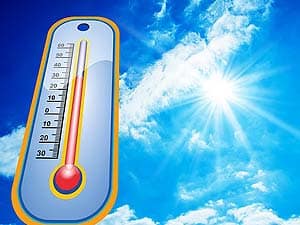
- Evolutionary stimuli for natural selection, such as UV radiation from the sun, is responsible for the difference in skin color in different regions and individuals.
- Too much exposure to UV radiation can increase the risk of skin cancer, infertility, and fetal deformities, to increased folate synthesis that does not allow for proper cell division.
- Too little exposure to UV radiation can lead to bone deformities such as rickets due to reduced production of Vitamin D.
![]()
A s single strand of hair is made up of many different parts.
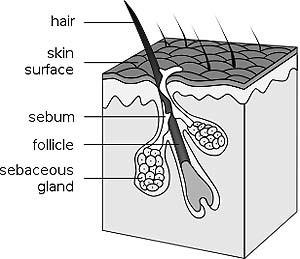
- Hair, also known as a pilus, is made up of different parts that give it its appearance.
- The part of the hair that lies above the surface of the skin is known as the hair shaft, and the portion that lies beneath the surface is known as the root.
- The root sits firmly in the dermis and the hypodermis and ends in a tubular structure known as the bulb.
![]()
Each strand of hair goes through a cycle of hair growth with three developmental stages.
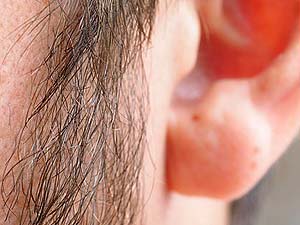
- Anagen, Catagen, and Telogen are three developmental phases that a single strand of hair goes through during its life cycle.
- Usually, approximately 90% of the hair cells are in the anagen phase, which is the active growing stage of the hair follicles.
- The Catagen stage is the point where active hair growth ceases, and hair strands can be easily pulled out from the root.
- The Telogen stage is the resting phase where hair growth stops and hair fall occurs.
![]()
Skin cancer is caused by damaging effects of UV radiation from the sun.

- There are two types of UV radiations: UVA range from 320-400nm, are of low energy, and are also called tanning rays.
- UVB rays are 290-320nm and are higher in energy than UVB rays, and are also called burning rays.
- UV rays induce DNA damage and DNA cross-links to form in the skin cells, leading to abnormal proliferation of skin cells and causing skin cancer.
![]()
Sun-screen contains a unique sun protection factor that can protect skin from harmful UV radiations.

- Many manufacturers offer skin products and creams that are imbibed with a particular factor called the Sun protection factor or SPF that claims to protect from harmful UV rays.
- The recommended SPF content is SPF15, which protects the skin from 94% of UVB rays.
- A higher SPF value does not mean the product offers a higher level of protection from UV rays.
![]()
There are two kinds of sweat glands in the integumentary system.
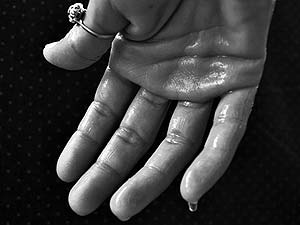
- Sweat glands, also known as sudoriferous glands are of two types – Apocrine and merocrine.
- Merocrine sweat glands are found all over the rest of the body, mainly on the palms of the hands, soles of the feet, and the forehead. The ducts of these glands open into a skin pore on the skin’s surface.
![]()
As you can see above, the integumentary system is a vital organ system of the human body, responsible for protection against harmful UV radiation and environmental pathogens.
![]()






















